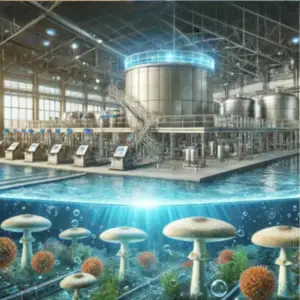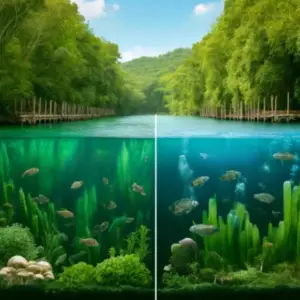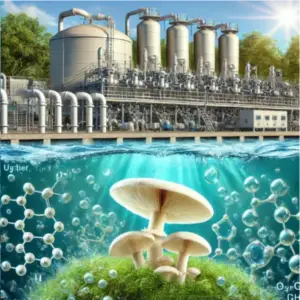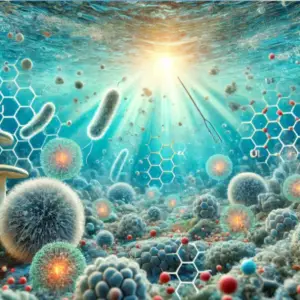1. What is Mushroom Chitosan?
Origin and Abundance
- Chitin is the second most abundant natural polysaccharide in nature, after cellulose.
- Most fungi contain 5%-7% chitin in their cell walls.
- Chitin is also found in the exoskeletons of crustaceans (crabs, shrimp, lobsters) and insects.
Pronunciation Guide
- Chitin: Pronounced “KITE-in” (emphasis on “kite”)
- Deacetylation: Pronounced “dee-a-SETTLE-ay-shun” (emphasis on “dee”)
- Acetyl: Pronounced “A-see-tl” (emphasis on “see”)
Chemical Structure and Properties
Chitosan is obtained through a process called deacetylation of chitin. This involves:- Removing acetyl groups (CH3OH) from the chitin molecule
- Creating a polymer with free amine groups (NH2)
-
- Solubility: Unlike chitin, chitosan is soluble in acidic to neutral solutions, making it more versatile for various applications. Our food grade mushroom chitosan oligosaccharide is soluble in water at any pH. It is bactericidal at pH 6.4 and below. To purchase wholesale, click HERE
-
- Biocompatibility and Biodegradability: Chitosan is known for its excellent biocompatibility and biodegradability. It’s non-toxic and can be broken down by natural biological processes.
Uses and Applications:
- Healthcare and Pharmaceuticals: Chitosan’s biocompatibility makes it invaluable in medical applications. It is used in wound healing products, drug delivery systems, and as a biomaterial in tissue engineering. Its ability to promote healing and control drug release has made it a popular choice in the pharmaceutical industry.
- Environmental Protection: In water treatment, chitosan’s capacity to bind with heavy metals and other contaminants makes it an effective agent for purification processes. This property has led to its use in both industrial and municipal water treatment facilities.
- Agriculture: Farmers and agronomists utilize chitosan as a natural biostimulant and elicitor. It enhances plant growth and boosts resistance against pathogens, contributing to more sustainable agricultural practices.
- Food Industry: Chitosan serves multiple purposes in food production and preservation. It acts as an antimicrobial food additive and can be used to create edible films or coatings that extend the shelf life of perishable products.
- Beverage Production: In the alcoholic beverage industry, chitosan is employed for clarification of wines, beers, and whiskeys, helping to improve their clarity and stability.
- Dietary Supplements: The compound is also used in the production of dietary supplements, capitalizing on its potential health benefits.
- Plastics Industry: Chitosan’s biodegradable nature makes it an attractive option for developing eco-friendly plastic alternatives.

Variants:
- Traditional Chitosan: Traditionally sourced from marine crustaceans.
- Mushroom Chitosan: Derived from fungal sources, offering an alternative for those seeking non-animal derived products.
2. What are the advantages of Mushroom Chitosan?
Mushroom Chitosan is a type of chitosan derived from the cell walls of fungi. It has several advantages over traditional chitosan derived from shellfish, including:- Vegan and vegetarian-friendly: Mushroom chitosan is an excellent alternative for individuals who avoid animal-based products, such as those who follow a vegan lifestyle.
- Allergen-free: Traditional chitosan is derived from shellfish, which can cause allergic reactions in some people. Mushroom chitosan does not contain any shellfish-derived ingredients, making it an allergen-free option.
- Purer: Mushroom chitosan is often considered to be purer than traditional chitosan because it is derived from a single source, whereas traditional chitosan can be contaminated with other shellfish-related substances.
- Better solubility: Mushroom chitosan is more soluble than traditional chitosan, which makes it easier to incorporate into a variety of applications such as cosmetics, bioplastics, wound care and food.
- Improved bioavailability: Some studies have suggested that mushroom chitosan has higher bioavailability compared to traditional chitosan, which means that it can be absorbed and utilized more effectively by the body.

3. What are the benefits & functions of chitosan in water treatment?
Chitosan derived from sources like mushrooms presents unique benefits and functions in water treatment, primarily due to its natural properties and sustainable origins. Here are some of the key benefits and functions:
- Biodegradability and Eco-friendliness: Chitosan is biodegradable and derived from renewable resources, making it an environmentally friendly alternative to synthetic chemicals.

- Non-Toxicity: Being of natural origin, chitosan is non-toxic and safe for use in various applications, including potable water treatment, without introducing harmful residues.

- Antimicrobial Properties: Chitosan naturally inhibits the growth of bacteria and other pathogens (at ultra-low molecular weight and a very high degree of deacetylation), which enhances the microbial safety of treated water and extends its storage life.

Functions of chitosan in water treatment
- Heavy Metal Removal: Chitosan efficiently binds with heavy metals (like lead, arsenic, mercury, and cadmium) in water, facilitating their removal through processes such as chelation or ion exchange.

- Flocculation and Coagulation: It acts as a flocculant, causing suspended particles to aggregate into larger clumps that settle out of the water, thereby clarifying turbid water sources.

- Oil and Grease Removal: Chitosan has the ability to adsorb oils, fats, and greases from water, making it ideal for treating industrial effluents and contaminated runoffs.

- Reduction of Phosphates: It assists in reducing phosphate levels in water, which helps prevent eutrophication that can lead to excessive algae growth and other ecological issues in water bodies.

Each of these benefits and functions highlights the versatility and eco-friendly nature of chitosan in treating and improving water quality.
4. What is the working mechanism of chitosan used in water-treatment?
Chitosan works in water treatment through a variety of mechanisms that leverage its natural properties as a biopolymer. Here’s how it functions:
(1). Flocculation and Coagulation
Chitosan acts as a natural flocculant and coagulant. When added to water, it binds with suspended particles, including sediments, organic materials, and certain microorganisms. The positive charges on the chitosan molecules attract the negatively charged particles typically found in wastewater. This electrostatic attraction causes the particles to clump together into larger aggregates or flocs. These flocs are then large enough to be removed by settling or filtration. This process is crucial in clarifying water and reducing turbidity.

(2). Metal Ion Chelation
Chitosan has excellent chelating properties, allowing it to bind with heavy metal ions such as lead, mercury, and cadmium. The chitosan molecule has active groups like amino and hydroxyl groups that can complex with metal ions, forming stable, non-soluble complexes. This mechanism is highly beneficial for removing heavy metals from industrial wastewater, thereby preventing metal toxicity in aquatic environments.

(3). Adsorption
Apart from flocculation, chitosan is a powerful adsorbent. Its structure contains numerous binding sites that can adsorb and trap various contaminants, including oils, phosphates, and organic pollutants. This property is especially useful for cleaning up oil spills and removing organic compounds that can contribute to chemical oxygen demand (COD) and biological oxygen demand (BOD) in water bodies.

(4). Antimicrobial Activity
Chitosan exhibits natural antimicrobial properties against a range of pathogenic bacteria and fungi. This activity is primarily due to its ability to disrupt microbial cell membranes and precipitate cellular proteins. In water treatment, this property helps in reducing the microbial load, thereby improving the microbiological quality of the treated water.

(5). Biodegradability
As a biopolymer derived from natural sources, chitosan is fully biodegradable. This attribute ensures that it does not contribute to environmental pollution post-treatment, unlike some synthetic polymers used in similar applications. Its degradation products are non-toxic and can be safely assimilated back into the environment.

The versatility of chitosan in water treatment makes it an attractive option for a range of applications, particularly where there is a need for an eco-friendly approach that effectively addresses multiple types of water contaminants.
5. What are the forms of chitosan used in water treatment?
Chitosan can be used in various forms in water treatment processes, each suited for different applications depending on the specific requirements of the treatment system. The addition ratio of chitosan in water treatment can vary significantly based on the specific application, the form of chitosan used, and the characteristics of the water being treated. Here’s some common forms in which chitosan is utilized, along with an overview of typical addition ratios and suitable application areas for each form of chitosan and a guide on which type of chitosan might be suitable for each form based on their characteristics:
- Flakes or Granules: Chitosan flakes or granules are used in bulk for treating large volumes of water. They can be added directly to water where they act as coagulants or flocculants, helping to bind and precipitate suspended solids.
- Addition Ratio: Typically used at concentrations ranging from 1 to 10 mg/L, depending on the turbidity and type of contaminants.
- Application Areas: Useful for large-scale industrial and municipal wastewater treatment facilities where a significant reduction of suspended solids is required.
- Suitable Chitosan Type: Chitosan with a lower viscosity range (20-100 cps) is generally suitable for creating flakes or granules as it can be easily processed and is effective in adsorbing pollutants at these forms.
- Reason: Lower viscosity chitosan can penetrate and coat solids more effectively, enhancing flocculation and sedimentation processes.

- Powder: Chitosan powder is highly effective for quick dispersion in water. This form is particularly useful for precise dosage control in processes where rapid reaction times are needed, such as in the flocculation and sedimentation stages.
- Addition Ratio: Generally used at about 1 to 5 mg/L. The exact dosage can vary based on the specific needs like the presence of heavy metals or organic pollutants.
- Application Areas: Ideal for quick-response scenarios, such as emergency water treatment and smaller-scale applications where rapid dispersion and reaction are needed.
- Suitable Chitosan Type: Acid-soluble chitosan in the range of 100-500 cps. This range provides a good balance between solubility and reactivity, making it ideal for quick dispersion.
- Reason: Medium viscosity helps maintain a good rate of dissolution while being reactive enough for efficient contaminant binding.

- Solution: Chitosan can be dissolved in acid (usually acetic acid) to form a solution that can be easily dosed and mixed into water treatment systems. This form is beneficial for continuous treatment processes and allows for more uniform distribution of the chitosan throughout the water.
- Addition Ratio: Commonly dosed between 0.5 and 5 mg/L, though it might be higher for heavy contaminant loads.
- Application Areas: Suitable for continuous dosing in both industrial process water systems and municipal water treatment plants. It’s especially good for precise control over treatment in fluid systems.
- Suitable Chitosan Type: Chitosan hydrochloride and chitosan oligosaccharide.
- Reason: Both are highly soluble in water. Chitosan hydrochloride is particularly effective in acidic solutions, making it ideal for use in solution form. Chitosan oligosaccharide, being a low molecular weight chitosan, dissolves quickly and acts effectively in solution.

- Beads or Pellets: These are used in filtration processes. Chitosan beads or pellets can be packed into columns where they act as biofilters or adsorbents, removing contaminants like heavy metals and phosphates as water passes through them.
- Addition Ratio: Used primarily in filter systems rather than dosed by concentration. The volume and size of the filter unit determine the amount.
- Application Areas: Perfect for fixed-bed or column filtration systems where water passes through, such as in point-of-use water filters or tertiary treatment stages in wastewater plants.
- Suitable Chitosan Type: Carboxymethyl chitosan and higher viscosity acid-soluble chitosan (500-1000 cps, up to 1500 cps).
- Reason: These types have enough structural integrity to form beads or pellets, which are crucial for use in filtration systems. Carboxymethyl chitosan, due to its modified structure, can also offer enhanced adsorption properties for specific contaminants.

- Composite Materials: Chitosan is often combined with other materials like activated carbon, clay, or other biopolymers to enhance its properties. These composites can be tailored to target specific types of contaminants more effectively, such as heavy metals, dyes, or organic compounds.
- Addition Ratio: Highly variable; depends on the composite material’s intended function and the nature of the target contaminant.
- Application Areas: These are engineered for specific challenges like selective removal of dyes, heavy metals, or organic compounds, often used in industrial wastewater treatments where standard methods fall short.
- Suitable Chitosan Type: Depending on the target contaminant, combinations of acid-soluble chitosan (across all viscosity ranges), chitosan hydrochloride, and carboxymethyl chitosan can be used.
- Reason: The choice depends on the required reactivity and the physical properties needed in the composite material. Lower viscosities may be better for coatings, whereas higher viscosities might be used for structural components.

- Gels: Chitosan gels can be used in specialized applications where slower release or longer interaction times with water are necessary. They can be particularly useful in controlled release scenarios or when a sustained treatment effect is desired.
- Addition Ratio: Like beads, used based on the physical size and capacity of the treatment system rather than concentration.
- Application Areas: Used in controlled-release applications or when treatment requires prolonged contact with water, such as in slow processing industrial wastewater or remediation sites.
- Suitable Chitosan Type: Higher viscosity acid-soluble chitosan (1000-1500 cps) and carboxymethyl chitosan.
- Reason: Higher viscosity chitosan can form stable gels that are suitable for prolonged interaction with water. Carboxymethyl chitosan can be advantageous for its enhanced solubility and chemical modification, allowing for targeted contaminant removal.

Each of these forms allows chitosan to be utilized effectively in different stages and setups of water treatment, making the most of its beneficial properties for purifying water. The specific addition ratio and the choice of form should be optimized based on laboratory trials and pilot studies to ensure maximum efficiency and cost-effectiveness in a given treatment scenario. Each application and chitosan type offers specific properties that need to be matched to the water treatment challenge at hand. Experimental testing and pilot trials are often necessary to fine-tune the selection for optimal performance.
6. Which one is more suitable for water treatment, crustacean chitosan or vegetal chitosan?
Choosing between crustacean chitosan and vegetal chitosan for water treatment depends on several factors including effectiveness, cost, environmental considerations, and specific application requirements. Here’s a comparison to help determine which source might be more suitable:
Considerations for Water Treatment
- Effectiveness: Given its higher degree of deacetylation, chitosan may actually offer stronger binding capabilities for pollutants, which can enhance its efficiency in removing heavy metals and other contaminants from water. This makes it very effective in applications that require precise pollutant management.
- Cost and Availability: Although chitosan may still be more costly due to sourcing and processing requirements, its effectiveness might justify the higher price, especially in specialized or high-purity applications.
- Environmental and Ethical Considerations: The environmental benefits of chitosan remain significant. It’s an excellent option for projects prioritizing sustainability and for markets sensitive to the use of animal-derived products.
Application-Specific Suitability
- Water Treatment: Chitosan, with a very high degree of deacetylation, is particularly suitable for applications requiring high efficiency in contaminant removal, such as in potable water treatment or sensitive ecological areas. You may purchase any form of chitosan that is ideal for your application, in bulk, at wholesale prices, HERE
- Market Preferences: The preference for mushroom chitosan might also be stronger in regions or markets where there is a high demand for eco-friendly, vegan, or hypoallergenic products.
Given these points, vegetal chitosan could be more suitable than crustacean chitosan for many water treatment scenarios, especially where performance in pollutant binding and environmental considerations are paramount. Meanwhile, considering the cost differences and specific properties of each type of chitosan:
- Crustacean Chitosan is often chosen for wastewater treatment in industrial settings primarily due to its lower cost. This makes it a practical option for large-scale applications where vast quantities of water need treatment, and the slightly lower degree of deacetylation is sufficient for the required level of contaminant removal.
- Mushroom Chitosan, with its higher degree of deacetylation, is better suited for applications requiring a higher purity of treated water, such as in swimming pools. Its ability to more effectively bind with contaminants can ensure a cleaner, safer water environment, which is particularly important in public or recreational water systems where human contact is frequent.
This strategic use of different types of chitosan based on the application requirements and budget constraints helps optimize both performance and cost-efficiency in water treatment processes.
7. Which type of chitosan is particularly suitable for the specified water treatment applications?
To provide a comprehensive guideline about which type of chitosan is suitable for each form and their corresponding water treatment application areas, here’s an overview based on their viscosity ranges and chemical forms:
1. Acid-Soluble Chitosan
- 20-100cps:
- Suitable Form: Solution or fine powder.
- Application Areas: Suitable for applications requiring rapid reaction and high dispersion, such as drinking water treatment and small-scale water purification systems.
- Reason: This low viscosity facilitates quick dissolution and dispersion in water, allowing for rapid interaction with contaminants. It’s ideal for treating drinking water or small-scale systems where fast and efficient treatment is required to ensure safety and clarity.
- 100-500cps:
- Suitable Form: Powder or solution.
- Application Areas: Ideal for municipal water treatment, pool water purification, and other applications needing moderate to high solubility and effective pollutant removal.
- Reason: A medium viscosity level provides a balance between ease of handling and substantive performance, allowing it to effectively remove a wide range of pollutants. It’s particularly effective in systems where thorough mixing and moderate reaction times are favorable, such as in municipal or recreational water treatment.
- 500-1000cps:
- Suitable Form: gel.
- Application Areas: Useful in industrial wastewater treatment where higher viscosity aids in the flocculation process and in systems requiring sustained interaction with water.
- Reason: Higher viscosity helps in forming robust gels that can interact with water over a longer duration, which is advantageous for industrial applications where continuous or extensive contact is necessary for effective pollutant binding and removal.
2. Acid-Soluble Crustacean Chitosan
- 20-200cps:
- Suitable Form: Solution or fine powder.
- Application Areas: Effective for general wastewater treatment in industries, where low viscosity facilitates quick dispersion and easy mixing.
- Reason: The lower viscosity range allows for easier mixing and faster chemical reactions, making it suitable for industrial wastewater treatment where efficient and straightforward applications are needed.
- 1000cps-1500cps:
- Suitable Form: Beads, pellets, or thick gel.
- Application Areas: Best suited for water treatment scenarios that benefit from slow-release properties, such as in tertiary treatment stages or specialized filtration systems.
- Reason: High viscosity is beneficial for forming beads or pellets used in filtration systems, providing a sustained release or interaction with water. This is ideal for advanced treatment stages where longer contact times can enhance the removal of stubborn or minute contaminants.
3. Chitosan Hydrochloride
- Suitable Form: Solution.
- Application Areas: Highly soluble in water, making it ideal for use in medical, pharmaceutical, and fine chemical industries where precise dosage and rapid solubility are required.
- Reason: This form is highly soluble in water and can be readily absorbed by biological systems, making it ideal for precise dosing in applications that require exact control and immediate action, such as in pharmaceutical and fine chemical water treatment processes.
4. Chitosan Oligosaccharide
- Suitable Form: Solution or fine spray.
- Application Areas: Due to its low molecular weight and high solubility, it’s particularly suitable for applications where quick bioactivity is essential, such as in potable water treatment and in scenarios requiring rapid microbial action.
- Reason: Its low molecular weight enhances its solubility and bioactivity, making it especially effective for rapid microbial inhibition or degradation in potable water systems where safety and quick response are critical.
5. Carboxymethyl Chitosan
- Suitable Form: Beads, pellets, or solution.
- Application Areas: Given its enhanced solubility and chemical stability, it’s useful in more chemically challenging water treatment processes, like removing organic pollutants and heavy metals from highly contaminated industrial effluents.
- Reason: Modified to enhance its solubility and stability in a variety of pH environments, this type is particularly suitable for treating highly contaminated industrial effluents. Its chemical modifications allow it to bind more effectively with organic pollutants and heavy metals, which are often challenging to remove with standard chitosan.
Each type of chitosan and its corresponding form has specific advantages that make it suitable for different water treatment scenarios. The selection of a particular type and form of chitosan should consider factors like the nature of the water to be treated, the specific contaminants present, and the operational requirements of the treatment system. Moreover, each of these chitosan types brings specific advantages to water treatment processes, leveraging their inherent chemical properties to meet the unique demands of various applications. This strategic use ensures maximum efficiency in contaminant removal and treatment effectiveness.
8. What is the flowchart of mushroom chitosan production?
The production process of plant chitosan is mainly obtained by extracting raw materials, deproteinizing with dilute acid, deacetylating, drying, sieving, etc. Here is a simplified flowchart of the production process of mushroom chitosan for your reference.

- Starting Material: The process begins with mushroom material as the source.
- Filtration: The mushroom material undergoes a filtration process.
- Protein Removal: Proteins are then removed from the filtered material using an alkali solution.
- Ash Removal: Ash content is subsequently removed with acid.
- Chitin Extraction:
- Acid is added without bubbles to proceed to the next stage.
- Chitin is extracted, which is not soluble in acid.
- An acetylation step removes the acetyl groups from the chitin using sodium hydroxide (NaOH), converting it into chitosan, which is soluble in acid.
- Drying: The acid-soluble chitosan is then dried to produce the final mushroom chitosan product, showcased as a white powder.
- Chitosan Derivatives: Parallel to the drying process, there is a branch leading to the production of various chitosan derivatives:
- Chitosan Hydrochloride: Chitosan converted into its hydrochloride form.
- Enzyme Hydrolysis: Produces chitosan oligosaccharide through enzymatic hydrolysis.
- Carboxymethyl Chitosan: Derived through the carboxymethylation of chitosan.
The flowchart depicts a methodical approach to converting mushroom material into various forms of chitosan, focusing on the purification and chemical modification steps necessary to achieve different chitosan-based products for use in various applications.
9. Summary chitosan in water treatment
Chitosan, derived from sources such as mushrooms and shellfish, represents a breakthrough in eco-friendly water treatment technologies. With its higher degree of deacetylation compared to traditional crustacean-based chitosan, mushroom chitosan offers superior efficacy in binding and removing a wide range of contaminants, including heavy metals, oils, and phosphates. This makes it especially valuable in applications requiring high purity water, such as in drinking water systems and swimming pools, where safety and environmental sustainability are paramount. Furthermore, mushroom chitosan’s biodegradability and non-animal origin make it an ideal choice for sectors looking to meet stringent environmental regulations and appeal to ethically-conscious consumers. Its ability to function effectively across a spectrum of pH levels and its compatibility with other water treatment agents allow for versatile integration into existing treatment infrastructures.

As industries and municipalities increasingly prioritize green solutions, mushroom chitosan stands out as an efficient, environmentally responsible option for modern water purification needs. While mushroom chitosan might be less cost-effective compared to crustacean chitosan due to its higher production costs, its superior effectiveness in certain applications and its environmentally friendly profile still make it a compelling choice for specific water treatment scenarios. These include settings where a higher degree of purity is necessary, or where environmental sustainability and non-animal origin products are prioritized. Despite its higher price, the demand for mushroom chitosan continues to grow in sectors focused on eco-conscious water purification practices, reflecting its value in meeting rigorous environmental and safety standards. Buy Mushroom Chitosan in bulk at wholesale prices HERE
Book a Free Consultation
If you don’t know what type of chitosan is best for your situation, Book an appointment. we will offer you an initial 30-minute consultation and product quotation at no charge.



